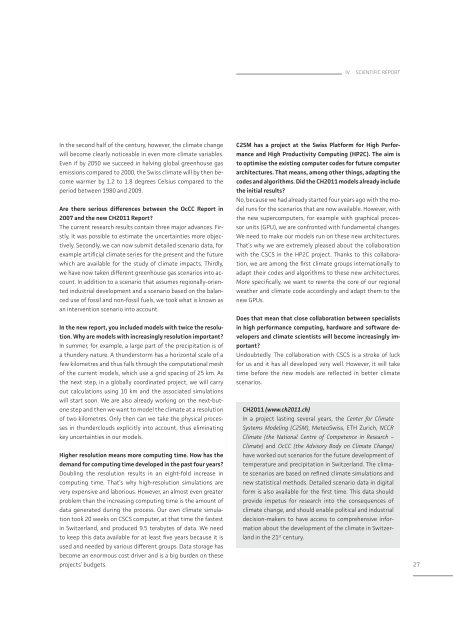Annual Report 2011 - CSCS
Annual Report 2011 - CSCS
Annual Report 2011 - CSCS
You also want an ePaper? Increase the reach of your titles
YUMPU automatically turns print PDFs into web optimized ePapers that Google loves.
In the second half of the century, however, the climate change<br />
will become clearly noticeable in even more climate variables.<br />
Even if by 2050 we succeed in halving global greenhouse gas<br />
emissions compared to 2000, the Swiss climate will by then become<br />
warmer by 1.2 to 1.8 degrees Celsius compared to the<br />
period between 1980 and 2009.<br />
Are there serious differences between the OcCC <strong>Report</strong> in<br />
2007 and the new CH<strong>2011</strong> <strong>Report</strong>?<br />
The current research results contain three major advances. Firstly,<br />
it was possible to estimate the uncertainties more objectively.<br />
Secondly, we can now submit detailed scenario data, for<br />
example artificial climate series for the present and the future<br />
which are available for the study of climate impacts. Thirdly,<br />
we have now taken different greenhouse gas scenarios into account.<br />
In addition to a scenario that assumes regionally-oriented<br />
industrial development and a scenario based on the balanced<br />
use of fossil and non-fossil fuels, we took what is known as<br />
an intervention scenario into account.<br />
In the new report, you included models with twice the resolution.<br />
Why are models with increasingly resolution important?<br />
In summer, for example, a large part of the precipitation is of<br />
a thundery nature. A thunderstorm has a horizontal scale of a<br />
few kilometres and thus falls through the computational mesh<br />
of the current models, which use a grid spacing of 25 km. As<br />
the next step, in a globally coordinated project, we will carry<br />
out calculations using 10 km and the associated simulations<br />
will start soon. We are also already working on the next-butone<br />
step and then we want to model the climate at a resolution<br />
of two kilometres. Only then can we take the physical processes<br />
in thunderclouds explicitly into account, thus eliminating<br />
key uncertainties in our models.<br />
Higher resolution means more computing time. How has the<br />
demand for computing time developed in the past four years?<br />
Doubling the resolution results in an eight-fold increase in<br />
computing time. That’s why high-resolution simulations are<br />
very expensive and laborious. However, an almost even greater<br />
problem than the increasing computing time is the amount of<br />
data generated during the process. Our own climate simulation<br />
took 20 weeks on <strong>CSCS</strong> computer, at that time the fastest<br />
in Switzerland, and produced 9.5 terabytes of data. We need<br />
to keep this data available for at least five years because it is<br />
used and needed by various different groups. Data storage has<br />
become an enormous cost driver and is a big burden on these<br />
projects’ budgets.<br />
IV SCIENTIFIC REPORT<br />
C2SM has a project at the Swiss Platform for High Performance<br />
and High Productivity Computing (HP2C). The aim is<br />
to optimise the existing computer codes for future computer<br />
architectures. That means, among other things, adapting the<br />
codes and algorithms. Did the CH<strong>2011</strong> models already include<br />
the initial results?<br />
No, because we had already started four years ago with the model<br />
runs for the scenarios that are now available. However, with<br />
the new supercomputers, for example with graphical processor<br />
units (GPU), we are confronted with fundamental changes.<br />
We need to make our models run on these new architectures.<br />
That’s why we are extremely pleased about the collaboration<br />
with the <strong>CSCS</strong> in the HP2C project. Thanks to this collaboration,<br />
we are among the first climate groups internationally to<br />
adapt their codes and algorithms to these new architectures.<br />
More specifically, we want to rewrite the core of our regional<br />
weather and climate code accordingly and adapt them to the<br />
new GPUs.<br />
Does that mean that close collaboration between specialists<br />
in high performance computing, hardware and software developers<br />
and climate scientists will become increasingly important?<br />
Undoubtedly. The collaboration with <strong>CSCS</strong> is a stroke of luck<br />
for us and it has all developed very well. However, it will take<br />
time before the new models are reflected in better climate<br />
scenarios.<br />
CH<strong>2011</strong> (www.ch<strong>2011</strong>.ch)<br />
In a project lasting several years, the Center for Climate<br />
Systems Modeling (C2SM), MeteoSwiss, ETH Zurich, NCCR<br />
Climate (the National Centre of Competence in Research –<br />
Climate) and OcCC (the Advisory Body on Climate Change)<br />
have worked out scenarios for the future development of<br />
temperature and precipitation in Switzerland. The climate<br />
scenarios are based on refined climate simulations and<br />
new statistical methods. Detailed scenario data in digital<br />
form is also available for the first time. This data should<br />
provide impetus for research into the consequences of<br />
climate change, and should enable political and industrial<br />
decision-makers to have access to comprehensive information<br />
about the development of the climate in Switzerland<br />
in the 21st century.<br />
27


